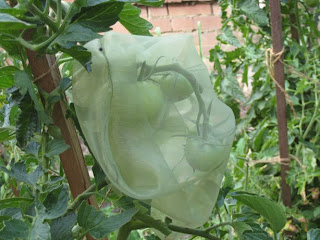It's not hard to grow some tomatoes. It really isn't. But if you want loads of sweet shiny bug-free tomatoes that go on for months then you need to know a few basics about what tomato plants like, and what likes tomato plants. Hopefully by keeping things general here, what worked for me will work for you, but you never know given all the possible combinations of soil, climate and location. My aim here is to get you started, for more info grab some locally written vegie gardening books and talk to some other gardeners in your area.
Soil
Tomatoes, like most vegies, don't like wet feet. They need a well drained soil or they're just not going to grow too well. Tomato plants are nutrient hungry, so FEED THEM. Composted animal manure is ideal, pelletised chicken manure is fine too. They also appreciate the occasional dose of potash (potassium sulfate) and fish emulsion or seaweed extract as a liquid fertiliser to keep things kicking along.
Sun
 Generally, unless you live in a very hot, dry location, full sun is the way to go. I've grown them in partial shade (maybe with 7 or 8 hours of direct sun a day) and they did just fine. If you stick them under a big tree they will hate you.
Generally, unless you live in a very hot, dry location, full sun is the way to go. I've grown them in partial shade (maybe with 7 or 8 hours of direct sun a day) and they did just fine. If you stick them under a big tree they will hate you.Climate
Tomatoes need a reasonably warm climate to fruit. Frost will make them dead. Most sources say germination and transplanting require a soil temperature of at least 15C. I've tried to get seedlings going at this sort of temperature and it takes a long time. A little greenhouse or heated propagator would no doubt help. I have neither so just wait until it's warm enough. Of course you could just buy the seedlings to get a head start, but that does limit you to the more common varieties. Warmer weather still is needed for fruit production. One trick in cooler areas is to grow them against a wall which faces the sun and retains the heat.
Bugs!
You won't be the only one in your garden who likes tomatoes. I have two main competitors where I am; caterpillars and fruit fly. Caterpillars hatch from eggs laid on the underside of leaves and quickly begin chewing holes in them. It's no problem losing a few leaves but they very quickly tire of foliage and take the express train to fruit city. Diligence is your first defense. Whenever you're in the garden look closely for holes in leaves and caterpillar poo. Check the underside of the leaves nearby and you'll most likely find the culprit there, trying very hard to look all green and tomato planty. The other pest I get is fruit fly, which appears here late in the summer when it's more humid. These are little fly things that inject their eggs into the fruit, where they hatch into yucky maggoty looking things that eat the fruit from the inside. The only evidence of this is tiny black spots on the skin, but when you cut open the fruit you find a whole load of wiggling nastiness. Rather than setting off some kind of toxic bomb I use fabric drawstring bags to prevent the fly getting to the fruit.
A few years ago we made a big batch of these bags, made from pale green organza fabric and they've lasted well with only a few needing repairs. I've also seen them commercially available if you don't have a sewing machine. They allow light and ventilation, but so long as the fabric is not stretched tight against the fruit they are effective in foiling the evil plans of both fruit fly and caterpillars. It's best to bag the fruit as soon as they start to form, or even when they're still flowers. Tomatoes self pollinate so do not need insects to pollinate the flowers.
A few years ago we made a big batch of these bags, made from pale green organza fabric and they've lasted well with only a few needing repairs. I've also seen them commercially available if you don't have a sewing machine. They allow light and ventilation, but so long as the fabric is not stretched tight against the fruit they are effective in foiling the evil plans of both fruit fly and caterpillars. It's best to bag the fruit as soon as they start to form, or even when they're still flowers. Tomatoes self pollinate so do not need insects to pollinate the flowers.
Good luck and good eating.



No comments:
Post a Comment